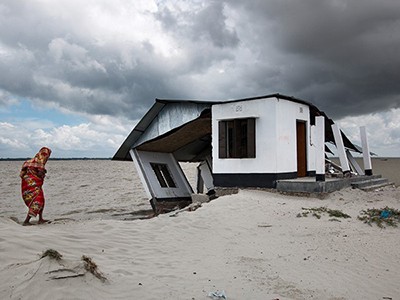[ad_1]
This year, thousands of people died and millions lost their homes in devastating floods in Bangladesh, Sudan and Pakistan. In East Africa, 50 million people are experiencing famine caused by the worst drought in 40 years. Around the world, at least half of the 59 million internal migrants in 2021 were displaced by the effects of climate change, according to the United Nations.
This is loss and damage — irreversible climate-related devastation that cannot be mitigated or adapted to. Dealing with it is pushing developing countries into ever-greater debt and their economies to the brink of collapse. The African Development Bank reported in September that the continent is losing between 5% and 15% of its growth in gross domestic product per capita each year because of climate change.
As the chair of the Least Developed Countries Group on Climate Change, I represent 46 nations that are home to nearly one billion people. This month, I will be among those calling on governments to establish a loss-and-damage fund for developing countries during COP27, the 27th Conference of the Parties to UN Framework Convention on Climate Change (UNFCCC) in Sharm El-Sheikh, Egypt. Research estimates that US$290 billion to US$580 billion per year will be needed by 2030.
The broken $100-billion promise of climate finance – and how to fix it
The people and communities I represent are those least responsible for carbon dioxide emissions — collectively contributing just 1.1% of global emissions in 2019. That’s less than half the emissions from cars and light trucks in the United States alone. We are hit first and worst by climate change and are least equipped to respond.
Those most responsible for global warming also have the greatest capacity to take action. Although the world’s richest 10% of people cause 50% of emissions, they also claim 52 % of the world’s wealth; the poorest 50% contribute around 10% of global emissions and receive about 8% of global income. Negotiators like me have been demanding action for 30 years.
So where is the concrete support for the people and communities worst affected? Last year, at COP26 in Glasgow, UK, low- and middle-income countries jointly proposed a Loss and Damage Finance Facility. Wealthy countries rejected this, and instead offered a three-year ‘dialogue’. Talk does not feed the starving or shelter the homeless.
Quite apart from the moral imperative — the ‘polluter pays’ principle — rich nations stand to gain from stabilizing the most vulnerable economies. The wealthiest benefit hugely from outflows of capital and commodities from the poorest: think interest payments on debt, or gold and other natural resources.
Limits to adaptation
High-income countries used to claim that loss and damage could be dealt with by adapting to the expected effects of drought, sea-level rise, flooding, heat and disease. It is true that there are (underfunded) mechanisms in the international climate architecture to finance some low-carbon development — renewables, say — and adaptation, such as flood defences. And it is indeed essential for the lowest-income countries to invest in resilience and renewable energy to navigate our rapidly warming world.
So why create a new fund for climate disaster support? Because when your house has been swept away, you need somewhere to sleep and something to eat, not money earmarked for wetland regeneration. As the Intergovernmental Panel on Climate Change’s alarming report in February indicated, change is happening faster than many communities can adapt to.
We are often told that humanitarian aid and development finance already provide what we are calling for. But such support — although crucial — is neither enough nor reliable. In the past five years, UN humanitarian aid appeals related to extreme weather events raised only half the money needed from donor countries, according to an analysis by international charity Oxfam.
‘COP26 hasn’t solved the problem’: scientists react to UN climate deal
Or we’re told that initiatives outside the UNFCCC aiming to ‘climate proof’ communities can address our needs. Naturally, we appreciate every such initiative. Early-warning systems, one focus, can save lives. Yet, early-warning systems do not rebuild homes or regrow crops. Insurance, another focus, can provide resources when needed — provided you can afford the premium, which is set to rise as impacts worsen, and as long as insurance remains available for risks such as flooding, fires and droughts, which continue to grow in frequency and certainty.
Here’s the irony: global fossil-fuel subsidies from 2021 alone reached US$697 billion. That could pay for the climate-related economic losses suffered by the most vulnerable countries from 2000 to 2019 and still have US$170 billion in profits left over.
So, what do I want to come away from COP27 with? Two things: first, a plan for the commitment made in Glasgow to at least double adaptation finance by 2025 through a system of public grants. Second, the establishment of a loss-and-damage finance facility with an equitable governing body, disbursing new funds. Ultimately, it is every country’s own choice how to secure the funding needed to support the most vulnerable. Creative funding sources could be explored, such as special drawing rights, or a carbon-damages tax on fossil-fuel companies. Debt cancellation can also usefully free up fiscal space. The fund should enact a clear way to identify funding needs and a fast track for emergencies. When your home is destroyed by climate change, do you want to be left to fend for yourself?
[ad_2]
Source link



